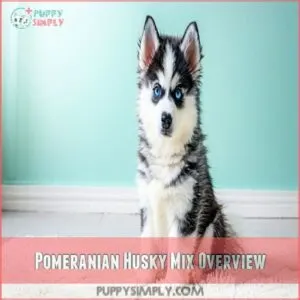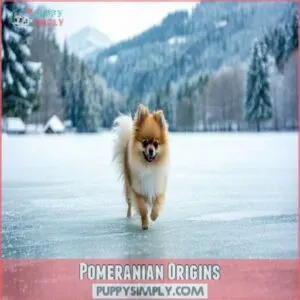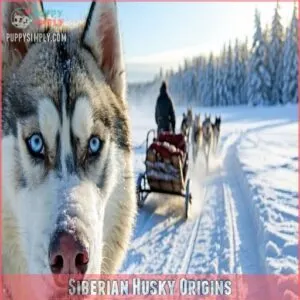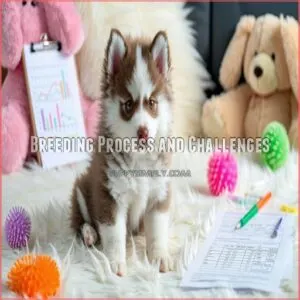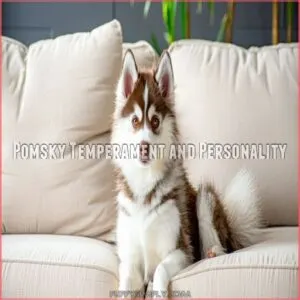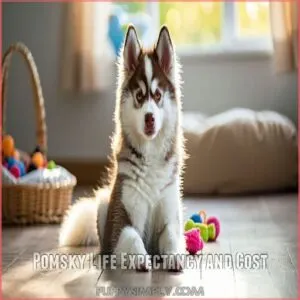This site is supported by our readers. We may earn a commission, at no cost to you, if you purchase through links.
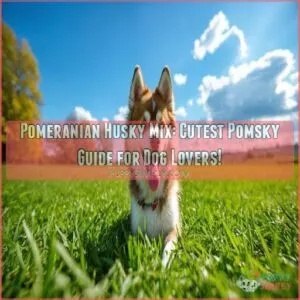 The Pomeranian Husky mix, or Pomsky, is a pint-sized bundle of energy that combines the fluff of a Pomeranian with the stunning features of a Siberian Husky.
The Pomeranian Husky mix, or Pomsky, is a pint-sized bundle of energy that combines the fluff of a Pomeranian with the stunning features of a Siberian Husky.
Weighing 10 to 30 pounds, this hybrid is as lively as it is adorable. Pomskies are smart, playful, and affectionate—think of them as the extroverts of the dog world.
They thrive on mental challenges like puzzles and need daily exercise to match their high-octane personalities.
Their double coat is gorgeous but sheds heavily, so grab that brush! With loyal hearts and expressive barks, Pomskies easily win your love—but will you keep up with theirs?
Table Of Contents
- Key Takeaways
- Pomeranian Husky Mix Overview
- Parent Breeds and History
- Pomsky Temperament and Personality
- Pomeranian Husky Mix Care
- Training and Socialization
- Pomsky Life Expectancy and Cost
- Finding a Pomeranian Husky Mix
- Frequently Asked Questions (FAQs)
- What is a Pomeranian Husky Mix (POMSKY)?
- What is a pomsky mix?
- How much does a Pomeranian husky mix cost?
- Is a pomsky a Siberian Husky?
- What is the best food for a Pomeranian husky mix?
- What is the temperament of a husky Pomeranian mix?
- Do Pomskies bite?
- Does the Pomeranian Husky Mix shed?
- What Are Teacup Pomeranian Huskies?
- Does the Pomeranian Husky stay small?
- Conclusion
Key Takeaways
- You’ll need to invest significant time in grooming, as Pomskies have a thick double coat that sheds heavily and requires 3-4 brushing sessions per week to maintain their gorgeous fur.
- They’re not just cute faces – Pomskies are incredibly intelligent dogs that demand mental stimulation through puzzles, training, and interactive games to keep their sharp minds engaged and prevent boredom.
- Your Pomsky will be an energetic companion that requires 30-45 minutes of daily exercise, combining physical activity with mental challenges to satisfy their high-octane Pomeranian and Husky heritage.
- Expect to budget between $2,000 and $5,000 upfront for your Pomsky, with annual ownership costs ranging from $2,000 to $3,000, covering everything from food and veterinary care to grooming and training.
Pomeranian Husky Mix Overview
If you’re dreaming of a compact, adorable dog that packs a punch of personality, the Pomeranian Husky mix, or Pomsky, might be your perfect companion.
These charming hybrid dogs combine the best traits of Siberian Huskies and Pomeranians, offering you a small-sized pet with big energy and an irresistible fluffy appearance.
Hybrid Breed Characteristics
Discover the realm of Pomskies, where inherited traits create a charming hybrid breed that’ll steal your heart.
Their adorable Pomeranian Husky mixes boast unique size variations, ranging from 10 to 30 pounds, with stunning coat colors that blend the best of both parents.
Their hybrid vigor guarantees a robust and charming companion that defies traditional breed expectations.
For Pomsky dogs owners, understanding the specific needs of this breed is vital for providing the best care.
Intelligence and Energy Levels
While hybrid looks catch your eye, a Pomsky’s mental prowess truly steals the show. These intelligent pups pack a serious brain-power punch.
Your pomeranian husky mix craves:
- Intelligent games that challenge their sharp minds
- Consistent mental stimulation through puzzles
- Regular energy release via active play
Their high-octane temperament demands engagement that keeps both body and brain firing on all cylinders.
Affectionate Personalities
After exploring their high-energy intelligence, Pomskies reveal another enchanting side: their heart-melting affection. These gentle souls are more than just adorable companions – they’re loyalty personified.
Their social connections run deep, creating unbreakable emotional bonds with their human families. To learn more about the Pomsky Care, understanding their needs and personality traits is vital.
| Affection Trait | Pomsky Characteristic |
|---|---|
| Cuddle Level | Maximum Attachment |
| Follow Behavior | Velcro Dog Syndrome |
| Communication | Vocal and Expressive |
| Family Bond | Intensely Loyal |
| Interaction Style | Playful and Loving |
These pomeranian husky mix dogs will steal your heart with their unwavering devotion and playful nature.
Parent Breeds and History
If you’re curious about the adorable Pomsky’s origins, you’ll find their story fascinating, tracing back to the unique lineage of Pomeranians and Siberian Huskies.
Bred first in 2012, these designer dogs emerged as a deliberate cross between two distinctive purebred breeds, quickly capturing the hearts of dog lovers worldwide.
Pomeranian Origins
From the snow-capped hills of Germany emerged the adorable Pomeranian, descending from the German Spitz lineage. These tiny toy companions started as larger working dogs before being bred down to their signature small size.
Royalty fell in love with the Pomeranian dog breed, transforming these pint-sized pups from practical farm helpers to beloved companion animals cherished across European courts.
The pomeranian husky mix has become increasingly popular due to its unique characteristics and charming appearance.
Siberian Husky Origins
Tracing back to the Siberian roots, Huskies emerged as legendary sled dogs among the Chukchi people of northeastern Asia.
These resilient working dogs survived harsh Arctic conditions, developing an incredible ability to pull sleds across unforgiving terrains.
Their remarkable endurance and strength made them invaluable companions, ultimately shaping the Siberian Husky breed we recognize today.
Breeding Process and Challenges
When the robust Siberian Husky meets the fluffy Pomeranian, creating a Pomsky isn’t just about mixing good looks. Breeding these adorable pups involves careful genetic testing and ethical considerations.
- Genetic compatibility challenges
- Size matching intricacies
- Health screening requirements
Responsible breeders must navigate intricate breeding protocols to guarantee healthy, well-tempered husky pomeranian mix puppies. They prioritize hybrid health, rigorous puppy socialization, and strategic breeder selection to produce the perfect Pomsky companion.
Pomsky Temperament and Personality
You’ll find the Pomsky to be an intelligent and energetic companion that brings boundless joy and playfulness to your home.
With their unique blend of Pomeranian and Husky traits, these dogs will quickly become your most entertaining and affectionate four-legged friend, offering a perfect mix of cuddly charm and spirited personality.
Sociable Traits
If you’re craving a furry friend who thrives on social interaction, the Pomsky might be your perfect match.
These pint-sized pups excel at pack dynamics, forming deep bonds with family members.
Their playful nature and innate canine friendship make them incredible companions who love cuddles, playtime, and being the center of attention in any social setting.
Intelligence and Trainability
Your Pomsky’s social spark leads perfectly into their stellar intelligence. These pups are canine problem-solving champions with remarkable brain development.
Here’s how their learning strategies shine:
- Quick comprehension of complex training methods
- Rapid skill acquisition through positive reinforcement
- Advanced problem-solving capabilities
- Adaptable learning demonstrating exceptional canine cognition
Their husky pomeranian temperament makes them brilliant companions who’ll keep you on your toes with their sharp minds.
Barking and Protective Instincts
Pomskies pack a powerful bark that reflects their watchdog heritage. These alert pups will sound the alarm when something seems off, channeling their protective Pomeranian and Husky instincts.
Their warning barks can be loud and frequent, especially around strangers or potential threats.
To learn more about the Pomeranian Husky breed, understanding their unique characteristics and needs is key. While their defensive behavior stems from a deep loyalty, consistent training helps manage excessive alarm barking and keeps their protective nature balanced.
Pomeranian Husky Mix Care
If you’re considering bringing a Pomsky into your life, you’ll need to be prepared for their unique care requirements that blend the traits of Pomeranians and Siberian Huskies.
Your new furry friend will demand dedicated attention to exercise, grooming, and health management to guarantee they thrive and remain a happy, energetic companion.
Exercise Needs and Recommendations
Between the lines of a Pomeranian Husky mix’s boundless energy lies a need for solid daily walks and dynamic playtime activities.
At least 30-45 minutes of exercise keeps your pomeranian husky mix physically and mentally sharp.
Mix up routines with dog sports classes, interactive games, and varied walking paths to challenge their athletic spirit and prevent boredom.
Grooming Requirements and Shedding
After keeping your Pomsky active, you’ll need to tackle their fur game. Their double coat demands serious attention during shedding seasons.
Here’s your quick Pomeranian Husky mix grooming guide:
- Brush 3-4 times weekly with a deshedding tool
- Use slicker brushes for removing loose undercoat hair
- Invest in professional-grade grooming tools for superior fur care
Consistent maintenance keeps your furry friend looking sharp and feeling comfortable.
Common Health Concerns and Issues
The genetic lottery of a Pomsky can bring eye problems and dental care challenges.
Like detectives solving a health mystery, you’ll want to stay proactive, using DNA tests and regular check-ups as your best defense against potential husky and pomeranian cross health issues.
Monitor your pup’s nutrition, watch for allergies, and keep those vet appointments to catch any concerns early.
Training and Socialization
When training your Pomsky, you’ll need to balance patience with consistent, positive reinforcement techniques that match their intelligent and sometimes stubborn nature.
You’ll want to start socialization early and establish a clear pack order to help your Pomsky become a well-adjusted, obedient companion who thrives on mental stimulation and structured learning.
Positive Reinforcement Techniques
Reward systems work wonders when training your pomsky using positive reinforcement.
Clicker training helps mark desired behaviors instantly, creating a clear communication path between you and your pomeranian husky mix.
By consistently rewarding good actions with treats, praise, or play, you’ll strengthen your bond and motivate your puppy to learn faster through operant conditioning.
Establishing a Clear Pack Order
Building on positive reinforcement, pack leadership with your pomeranian husky mix requires confident, consistent communication.
Alpha roles aren’t about dominance, but clear boundaries. Communicate through calm, assertive body language and predictable routines.
Your husky pomeranian wants to understand social structure—show them you’re the reliable guide they can trust by maintaining steady, patient interactions.
Socialization With Other Pets and People
Almost every Pomsky puppy needs early socialization to thrive in family dynamics. Start introducing your pomeranian husky mix to different people, pets, and environments gradually to develop strong social skills.
Understanding puppy socialization techniques is essential for raising a well-adjusted dog.
Controlled interactions help prevent anxiety and aggression, allowing your dog to become a confident, well-adjusted companion who understands boundaries and enjoys positive human and animal connections.
Pomsky Life Expectancy and Cost
If you’re considering a Pomsky, you’ll want to know they live 12 to 15 years and can cost between $2,000 and $5,000 upfront.
Understanding their life expectancy and ownership expenses will help you make an informed decision about whether this adorable breed fits your lifestyle and budget.
Average Lifespan of Pomskies
Understanding average lifespan is important for planning the best possible life for your pet. Pomsky lifespan typically ranges from 12 to 15 years, influenced by genetics, diet, and care.
After mastering training techniques, you’ll want to know how long your Pomsky companion might stick around. Health considerations and breed comparisons suggest these Pomeranian Husky mix pups enjoy a relatively healthy life when given proper attention, nutrition, and regular veterinary checkups.
Estimated Annual Cost of Ownership
Because Pomskies come with a hefty price tag, your annual budget should hover around $2,000 to $3,000.
This includes essential expenses like food costs ($500-$700), veterinary care ($300-$600), grooming prices ($200-$400), and training classes ($100-$300).
Don’t forget additional costs for toys, treats, and potential pet insurance that’ll help manage unexpected medical expenses.
Factors Affecting Cost and Lifespan
Whether you’re eyeing a new furry friend or budgeting for your Pomsky, several factors influence their price and lifespan.
Breeder reputation, diet, healthcare access, and exercise frequency can substantially impact your dog’s well-being.
Understanding the pomsky lifespan is vital for planning and preparation as a responsible owner.
Environmental factors and genetic health play key roles in determining how long your adorable Pomeranian Husky mix will be your loyal companion.
Finding a Pomeranian Husky Mix
When searching for your perfect Pomeranian Husky mix, you’ll want to carefully research reputable breeders and rescue centers that specialize in this unique hybrid breed.
Understanding the nuances of Pomsky adoption requires thorough investigation of breed-specific associations, health certifications, and responsible breeding practices to guarantee you bring home a healthy and well-socialized companion.
Reputable Breeders and Associations
After understanding your Pomsky’s potential costs, finding a responsible breeder becomes your next mission.
The Pomsky Club of America and International Pomsky Association offer credible breed registries.
Look for breeders who prioritize genetic health testing, provide clear puppy certifications, and demonstrate transparent kennel standards.
Learning about pomeranian husky characteristics is essential for making informed decisions.
Ethical pomeranian husky mix breeders will welcome your questions about their breeding practices and lineage.
Online Marketplaces and Rescue Centers
Exploring online listings for a pomeranian husky mix? Websites like pet forums, breeders directories, and rescue center platforms often showcase pomsky puppies or husky pomeranian rescues.
Opt for husky pomeranian adoption through verified pomsky rescue centers, ensuring ethical practices.
Always research the adoption process thoroughly, prioritize reputable sources, and watch out for scams when browsing pet marketplaces.
Considerations for Adopting a Pomsky
When thinking about adopting a Pomsky, consider your family dynamics, lifestyle changes, and commitment to husky Pomeranian training.
This husky Pomeranian breed thrives on attention and care.
Factor in the adoption process, pet insurance, and veterinary care costs.
Understanding Pomeranian Husky characteristics and health needs facilitates a happy adjustment.
Having pet insurance plans can help manage unexpected veterinary expenses.
Is your schedule ready for their energy?
Frequently Asked Questions (FAQs)
What is a Pomeranian Husky Mix (POMSKY)?
Imagine a pint-sized pup with the playful spirit of a Husky and the cuddly charm of a Pomeranian.
A Pomsky is a designer hybrid, combining striking looks, intelligence, and a vibrant personality in one fluffy package.
What is a pomsky mix?
A Pomsky mix combines traits from a Siberian Husky and a Pomeranian, resulting in a small, playful, and intelligent dog.
Their striking looks, energetic nature, and friendly demeanor make them a popular choice for pet owners.
How much does a Pomeranian husky mix cost?
You’ll typically spend $2,000 to $5,000 for a Pomeranian Husky mix, depending on the breeder, location, and pedigree. Some rare appearances or highly sought-after genetics could even push costs higher.
Is a pomsky a Siberian Husky?
A Pomsky isn’t a Siberian Husky—it’s a mix of a Siberian Husky and a Pomeranian.
This hybrid breed combines traits from both, offering a smaller, fluffy version of the Husky’s striking looks and lively personality.
What is the best food for a Pomeranian husky mix?
Over 50% of dogs are overweight, so choosing balanced food is essential.
Opt for high-quality kibble with lean protein, healthy fats, and essential nutrients.
Brands like Royal Canin or Wellness suit active Pomsky energy levels perfectly.
What is the temperament of a husky Pomeranian mix?
A Husky Pomeranian mix combines playfulness, intelligence, and loyalty.
They’re energetic, affectionate, and love attention but can be stubborn or independent.
Socialize early to manage their strong-willed side, and they’ll become a loving, lively companion.
Do Pomskies bite?
Around 5 million dog bites occur annually in the U.S.
Their playful nature means nipping might happen during rough play, but proper training curbs this behavior.
Pomskies rarely bite unless poorly trained or provoked.
Does the Pomeranian Husky Mix shed?
Yes, Pomskies shed, thanks to their fluffy double coat.
You’ll notice moderate shedding year-round and heavier shedding during seasonal changes.
Regular brushing helps control the fur mess and keeps their coat healthy and tangle-free.
What Are Teacup Pomeranian Huskies?
Teacup Pomeranian Huskies aren’t an official breed. They’re extremely small Pomskies bred to be miniature, often through unethical practices that can compromise the dog’s health and well-being.
Does the Pomeranian Husky stay small?
Like a chameleon adapting to its environment, your Pomeranian Husky won’t stay tiny forever.
Expect them to grow to 10-15 inches tall and weigh 20-30 pounds, blending the sizes of their Pomeranian and Husky parents.
Conclusion
Ultimately, the Pomeranian Husky mix is like a sparkling gem in the dog world—compact, brilliant, and full of surprises.
If you’re ready to welcome a Pomsky into your life, you’ll need patience, dedication, and a sense of adventure.
This pint-sized powerhouse will challenge and delight you, transforming your home into a playground of love and energy.
Remember, a well-trained Pomeranian Husky mix isn’t just a pet; it’s a loyal companion who’ll keep you on your toes.
- https://shrsl.com/4ap18
- https://www.akc.org/dog-breeds/pomeranian
- https://dogtime.com/dog-breeds/siberian-husky
- https://www.webmd.com/pets/dogs/cataracts-dogs
- http://www.dailymail.co.uk/femail/article-3651135/He-s-dog-Meet-Norman-picture-perfect-Pomsky-puppy-amassed-11-000-Instagram-followers-just-SIX-WEEKS-thanks-adorable-appearance.html

